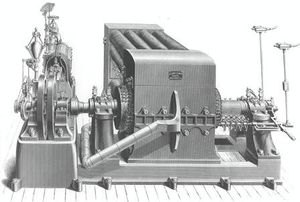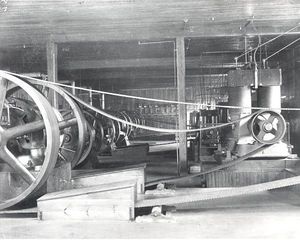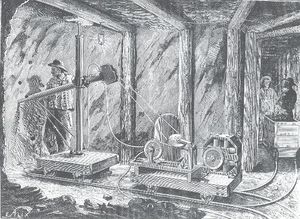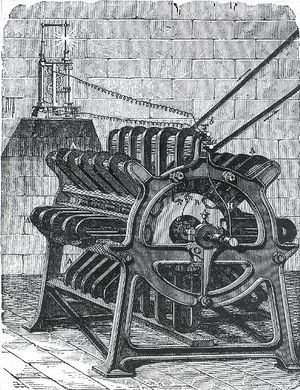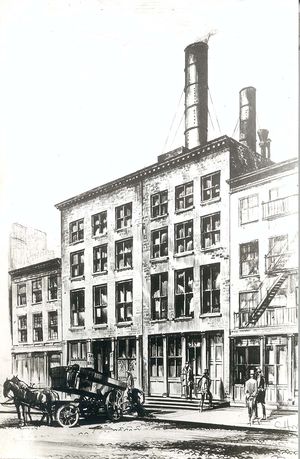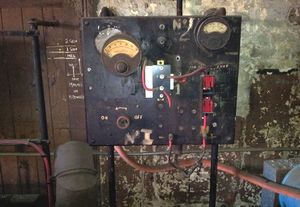Generators: Difference between revisions
No edit summary |
No edit summary |
||
| (3 intermediate revisions by 2 users not shown) | |||
| Line 1: | Line 1: | ||
== Generators == | == Generators == | ||
[[Image:Edison Dynamo 0166.jpg|thumb| | [[Image:Edison Dynamo 0166.jpg|thumb|right|Edison jumbo dynamo]] | ||
As its name suggests, a generator generates electricity. [[Michael Faraday|Michael Faraday’s]] discovery of electromagnetic induction demonstrated a way to construct a simple generator, but there was little need for such a device until commercial technologies that used electricity, such as lights, appeared. The earliest commercial uses of electricity, such as [[Telegraph|telegraphy]], [[Arc Lighting|arc lighting systems]], and metal electroplating used [[Batteries|batteries]] as their power source. This was a very expensive way of generating electricity. | As its name suggests, a generator generates electricity. [[Michael Faraday|Michael Faraday’s]] discovery of electromagnetic induction demonstrated a way to construct a simple generator, but there was little need for such a device until commercial technologies that used electricity, such as lights, appeared. The earliest commercial uses of electricity, such as [[Telegraph|telegraphy]], [[Arc Lighting|arc lighting systems]], and metal electroplating used [[Batteries|batteries]] as their power source. This was a very expensive way of generating electricity. | ||
| Line 11: | Line 11: | ||
In the 1860s and 1870s many inventors sought ways of using Faraday’s induction principle to generate electricity mechanically. Two kinds of generators emerged. The first type was a generator of direct current (DC) electricity. The second type was a generator of alternating current (AC) electricity. In truth, a DC generator could generate AC current, but it contains a simple device called a commutator to turn AC into DC. A commutator reroutes the flow of electrons inside the DC generator, so that the energy that appears at the output is a pulsing direct flow. An AC generator does not need a commutator and generates AC directly. | In the 1860s and 1870s many inventors sought ways of using Faraday’s induction principle to generate electricity mechanically. Two kinds of generators emerged. The first type was a generator of direct current (DC) electricity. The second type was a generator of alternating current (AC) electricity. In truth, a DC generator could generate AC current, but it contains a simple device called a commutator to turn AC into DC. A commutator reroutes the flow of electrons inside the DC generator, so that the energy that appears at the output is a pulsing direct flow. An AC generator does not need a commutator and generates AC directly. | ||
[[Image:Arc Lighting Dynamo 0217.jpg|thumb| | [[Image:Arc Lighting Dynamo 0217.jpg|thumb|right|Arc Lighting Dynamo]] | ||
One of the most important inventors of generators was German [[Werner von Siemens|Werner von Siemens]], who designed improved DC generators and called them [[Dynamo|dynamos]]. An even better generator was introduced by | One of the most important inventors of generators was German [[Werner von Siemens|Werner von Siemens]], who designed improved DC generators and called them [[Dynamo|dynamos]]. An even better generator was introduced by French Zénobe-Théophile Gramme in 1867, which produced substantially higher voltages than previous attempts. In 1871 he demonstrated a working model, and with Hippolyte Fontaine began manufacturing them. Gramme’s dynamos generated AC current and were widely used in arc lighting systems. In 1872, however, von Siemens reemerged and invented what is essentially the modern type of dynamo, referred to as the drum armature type of machine, which was a more efficient design. | ||
[[Image:1111-pearl street station exterior.jpg|thumb|right|Pearl Street Station]] | [[Image:1111-pearl street station exterior.jpg|thumb|right|Pearl Street Station]] | ||
| Line 21: | Line 21: | ||
As [[Electric Lighting|electric lighting]] and centrally distributed power began to achieve commercial success in the 1880s, inventors began looking for ways to distribute central-station power over longer distances. Edison’s DC system was poorly adapted to this, because he had chosen to use 120-volt bulbs and motors. A much higher voltage would have been easier to transmit down long wires, because at a low voltage much energy is lost as heat. Edison stations, such as that at Pearl Street, could be no more than about a mile from the customer. AC offered an alternative: a way to generate at a low voltage, “step up” the voltage for transmission using a simple device called a transformer, and then “step down” the voltage at the customer premises. The only remaining problem, though, was the lack of a suitable AC motor design. | As [[Electric Lighting|electric lighting]] and centrally distributed power began to achieve commercial success in the 1880s, inventors began looking for ways to distribute central-station power over longer distances. Edison’s DC system was poorly adapted to this, because he had chosen to use 120-volt bulbs and motors. A much higher voltage would have been easier to transmit down long wires, because at a low voltage much energy is lost as heat. Edison stations, such as that at Pearl Street, could be no more than about a mile from the customer. AC offered an alternative: a way to generate at a low voltage, “step up” the voltage for transmission using a simple device called a transformer, and then “step down” the voltage at the customer premises. The only remaining problem, though, was the lack of a suitable AC motor design. | ||
[[Nikola Tesla|Nikola Tesla]], a Serbian immigrant to the United States, devised an improved AC generator as well as a practical AC motor. Tesla’s system used polyphase AC, in which the generator generated several different AC flows that were combined or superimposed onto one another to create a single polyphase AC output, with the component currents “out of phase” with one another. The Tesla motor, introduced in 1887, was designed so that the peaks of this polyphase current supplied power at just the right moment in the rotation of the motor, and the resulting induction motor as he called it, ran smoothly. With a practical AC motor and generator in hand, along with [[Transformers|transformers]] to raise and lower voltage, Tesla’s system could be used by power companies to create ever-larger networks of power distribution using massive power plants, such as the Niagara Falls hydroelectric plant built in the 1890s. Larger power systems helped lower costs, which stimulated demand for electricity, especially in homes. | [[Nikola Tesla|Nikola Tesla]], a Serbian immigrant to the United States, devised an improved AC generator as well as a practical AC motor. Tesla’s system used polyphase AC, in which the generator generated several different AC flows that were combined or superimposed onto one another to create a single polyphase AC output, with the component currents “out of phase” with one another. The Tesla motor, introduced in 1887, was designed so that the peaks of this polyphase current supplied power at just the right moment in the rotation of the motor, and the resulting induction motor as he called it, ran smoothly. With a practical AC motor and generator in hand, along with [[Transformers|transformers]] to raise and lower voltage, Tesla’s system could be used by power companies to create ever-larger networks of power distribution using massive power plants, such as the Niagara Falls hydroelectric plant built in the 1890s. Larger power systems helped lower costs, which stimulated demand for electricity, especially in homes. | ||
[[ | [[Image:Brewery generator board.jpg|thumb|right]] | ||
[[Category:News]] | |||
[[Category:Lasers,_lighting_&_electrooptics]] | |||
[[Category:Light_sources]] | |||
[[Category:Electric_lighting]] | |||
[[Category:Power,_energy_&_industry_application]] | |||
[[Category:Power_generation]] | |||
Revision as of 13:00, 2 August 2012
Generators
As its name suggests, a generator generates electricity. Michael Faraday’s discovery of electromagnetic induction demonstrated a way to construct a simple generator, but there was little need for such a device until commercial technologies that used electricity, such as lights, appeared. The earliest commercial uses of electricity, such as telegraphy, arc lighting systems, and metal electroplating used batteries as their power source. This was a very expensive way of generating electricity.
In the 1860s and 1870s many inventors sought ways of using Faraday’s induction principle to generate electricity mechanically. Two kinds of generators emerged. The first type was a generator of direct current (DC) electricity. The second type was a generator of alternating current (AC) electricity. In truth, a DC generator could generate AC current, but it contains a simple device called a commutator to turn AC into DC. A commutator reroutes the flow of electrons inside the DC generator, so that the energy that appears at the output is a pulsing direct flow. An AC generator does not need a commutator and generates AC directly.
One of the most important inventors of generators was German Werner von Siemens, who designed improved DC generators and called them dynamos. An even better generator was introduced by French Zénobe-Théophile Gramme in 1867, which produced substantially higher voltages than previous attempts. In 1871 he demonstrated a working model, and with Hippolyte Fontaine began manufacturing them. Gramme’s dynamos generated AC current and were widely used in arc lighting systems. In 1872, however, von Siemens reemerged and invented what is essentially the modern type of dynamo, referred to as the drum armature type of machine, which was a more efficient design.
AC and DC generators were both used from the 1870s on. For example, AC generators were used in a type of outdoor arc lighting known as the Jablochkoff Candle. However, in the late 1870s when Thomas Edison devised his highly successful electric lighting system, he used DC generators. A major reason for this choice was that Edison wanted to use electric power both for lighting (for which AC was fine) and for running electric motors. At the time, there was no good AC electric motor available, so DC was the only option. In 1882 Edison installed DC generators at the Pearl Street station facilities in New York City, one of the earliest commercial power generating plants.
As electric lighting and centrally distributed power began to achieve commercial success in the 1880s, inventors began looking for ways to distribute central-station power over longer distances. Edison’s DC system was poorly adapted to this, because he had chosen to use 120-volt bulbs and motors. A much higher voltage would have been easier to transmit down long wires, because at a low voltage much energy is lost as heat. Edison stations, such as that at Pearl Street, could be no more than about a mile from the customer. AC offered an alternative: a way to generate at a low voltage, “step up” the voltage for transmission using a simple device called a transformer, and then “step down” the voltage at the customer premises. The only remaining problem, though, was the lack of a suitable AC motor design.
Nikola Tesla, a Serbian immigrant to the United States, devised an improved AC generator as well as a practical AC motor. Tesla’s system used polyphase AC, in which the generator generated several different AC flows that were combined or superimposed onto one another to create a single polyphase AC output, with the component currents “out of phase” with one another. The Tesla motor, introduced in 1887, was designed so that the peaks of this polyphase current supplied power at just the right moment in the rotation of the motor, and the resulting induction motor as he called it, ran smoothly. With a practical AC motor and generator in hand, along with transformers to raise and lower voltage, Tesla’s system could be used by power companies to create ever-larger networks of power distribution using massive power plants, such as the Niagara Falls hydroelectric plant built in the 1890s. Larger power systems helped lower costs, which stimulated demand for electricity, especially in homes.
